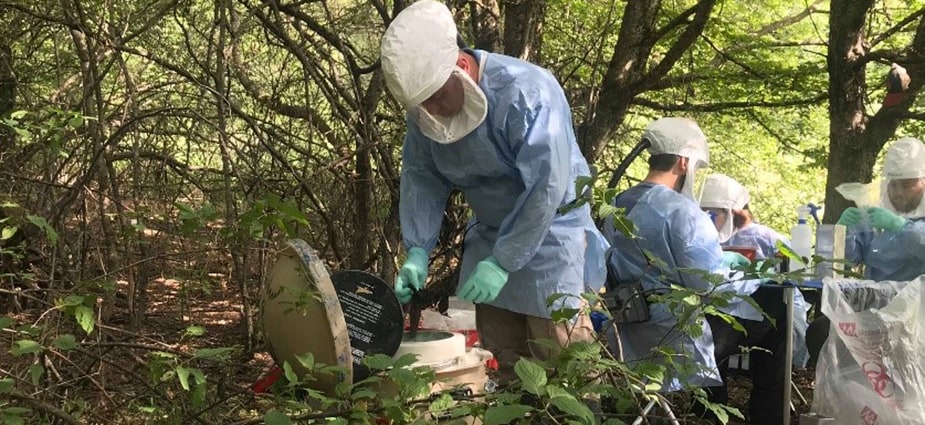Science, Monitoring & Evaluation, and Applied Research
Advancing evidence-based decision-making through science, monitoring and evaluation, and applied research

Orthopox field team processing small mammal samples in Akhmeta municipality, Georgia. Photo: Giorgi Maghlakelidze
Science, monitoring and evaluation, and applied research are essential to understand the root causes of disease, how they spread, and how to protect Americans and people worldwide from deadly infectious diseases and other public health threats. The Division of Global Health Protection (DGHP) supports evidence-based decision-making by:
- Monitoring and evaluating our public health programs and initiatives in over 30 countries
- Providing data management guidance and support to global health partners
- Collecting, analyzing, managing, and reporting public health data
- Examining public health best practices through applied research
Our goal is to improve global health security (GHS) by providing training, technical assistance, reports, and peer-reviewed journal publications to our network of public health partners. We work with partners to strengthen core capacities in workforce development, surveillance systems, laboratory systems, and emergency preparedness and response.
How Does DGHP Use Science and Applied Research?
To use resources efficiently and maximize returns on investments in scientific and programmatic work, DGHP established a Strategic Science Framework. This framework guides our science, evaluation, and applied research work and focuses on three domains to:
- Determine Most Effective Implementation Approaches: Develop an evidence-base to build GHS capacity and capture the most effective means of responding to global public health threats.
- Measure Impact: Conduct studies, assessments, and evaluations to measure or model the impact of DGHP-facilitated programs through innovative research methods and strategies.
- Characterize Public Health Threats: Examine public health challenges that threaten GHS and may have a negative impact on global health outcomes.
The framework also ensures that DGHP’s work and partnerships align with the division’s mission, goals, and objectives, address gaps in GHS implementation, and provide recommendations using evidence-based best practices.
DGHP helps countries build capacity to prevent, detect, and respond to public health threats and enhance GHS, in partnership with other CDC programs, U.S. government agencies (e.g., U.S. Department of State, U.S. Department of Defense, U.S. Agency for International Development, National Security Council), foreign ministries (e.g., health, agriculture), the World Health Organization (WHO), and other partners worldwide.
CDC has over 60 years of global experience, and DGHP is leading its GHS implementation work. Our access to scientists and technical experts with in-depth knowledge, skills, and experience helps DGHP strengthen capabilities in resource-limited settings. With emerging and re-emerging infectious disease outbreaks, pandemics, natural and man-made disasters, and noncommunicable diseases on the rise, it is critical that we use research and applied science to identify gaps and strengthen GHS.
DGHP facilitates the creation of scientific reports and publications based on applied research to help countries respond more effectively to public health crises. The following supplements are examples of DGHP-led publications that provide evidence to improve GHS:
- Health Security Supplement: What Works? Lessons Learned in Global Health Security Implementation (2020)
- Global Disease Detection Supplement: Ten Years of Global Disease Detection and Counting: Program Accomplishments and Lessons Learned in Building Global Health Security (2019)
- Health Security Supplement: Building the Evidence Base for Global Health Security (2018)
- Emerging Infectious Diseases Global Health Security Supplement (2017)
Learn more about our high impact scientific work on our Scientific Publications page.
Moving forward, DGHP plans to increase the quantity and quality of scientific work to positively impact GHS implementation through assessments, evaluations, and publications. Additionally, we aim to build a robust network of regional and country platforms that share quality epidemiologic, laboratory-based, and GHS program implementation data, and to promote collaboration and partnerships.

Juvenile woolly monkeys drinking from a fountain at a rescue facility in Iquitos, Peru. Photo: Stephanie Salyer
DGHP strengthens research systems through a variety of programs, including:
Active Programs
- Emergency Response and Recovery
- Field Epidemiology Training Program
- Global Health Security Agenda
- Global Noncommunicable Disease Program
Recently Retired Programs
Read our stories about research:
Learn more through our research infographics: